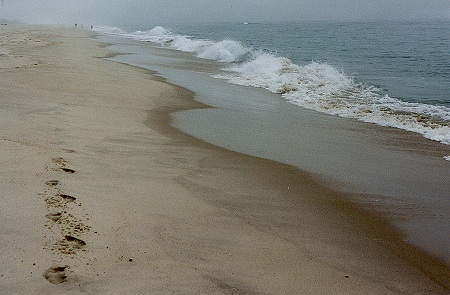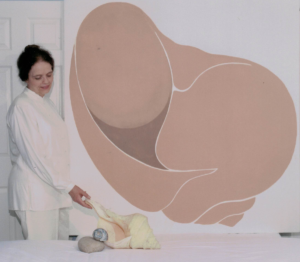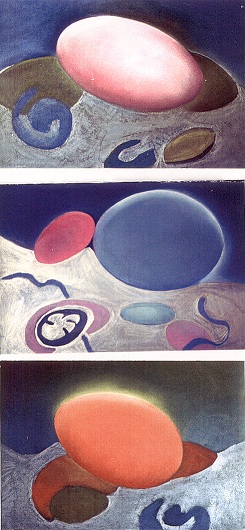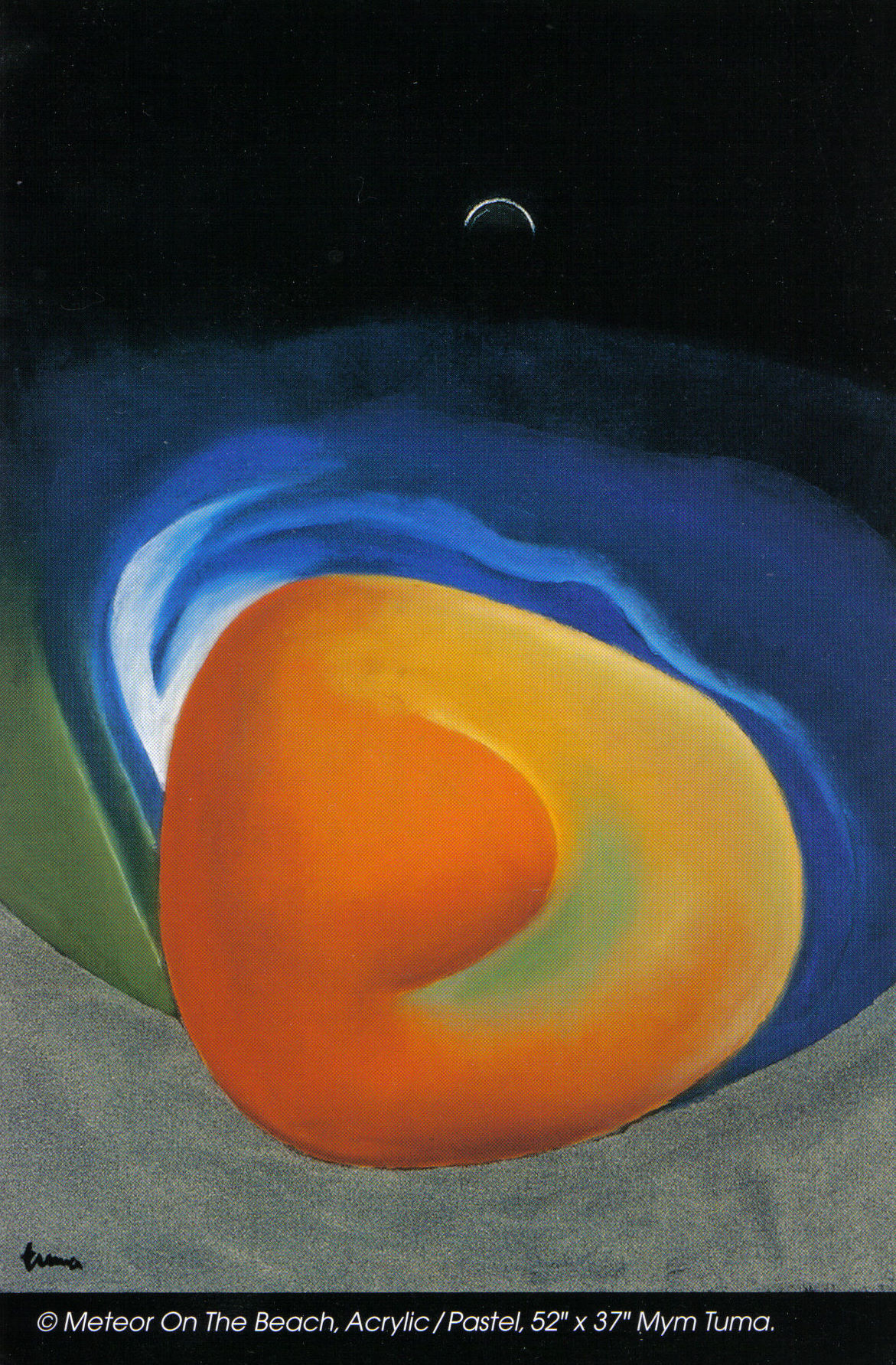
God's Architecture
OVERVIEW OF GOD’S ARCHITECTURE: THE SPIRAL/SPHERE
Text, photos & captions copyright by Mym Tuma 2009
What we call G-d’s Architecture by definition is stable, fundamental. The architecture of the Moon and the Earth are spherical. Our galaxy is a spiral; there’s a spiral in your ear. The wave action of the sea forms rocks into pebbles.
“Our seashore is the front lines between land and wind driven tides. It is a cauldron of regeneration. The inter tidal zone or boundary of rocky shores and beaches is prime real estate for ocean born creatures and shapes”

The fecundity of the ocean runs through this exhibition of my art. I accomplished it in three mediums: soft pastels, acrylics and epoxy resins and in the process, I also write poetry.
The Sea as the architect, creates architecture. It uses forces of nature, wind/water, and tides. Reducing boulders to pebbles and sand…the exhibit wall and poem, “The Helix In White Space”
The Blue Dot
The blue rock that casts a shadow is going to be seen as a Blue Dot in an epoxy form, 24″ x 24″.
The blue dot that is spherical like our beautiful blue planet in the acrylic painting is now represented on the The Blue Dot, an epoxy Sculptured Painting TM These are hollow shells. One of these limited edition pieces was sent to the former Vice president, Al Gore, to show I appreciated his landmark book, “An Inconvenient Truth”…
Al Gore included a photo of Earth as a tiny blue dot in our galaxy taken twenty years ago, after the late Carl Sagan suggested that the NASA satellite turn its camera back toward Earth again and from that unimaginable distance, take another photograph of Earth…Sagan called it a pale blue dot and noted that everything that has ever happened in all of human history, that we’ve ever known has taken place here. This is the environment that we seek to preserve. In accepting the work, VP Gore wrote, “it conveys a wonderful message! Tipper and I look forward to finding the perfect place for it.” (letter, dated June 3, 2008).
Preface
In this online exhibit, I build on the theme “God’s Architecture: the Spiral/Sphere,” at the Quogue Gallery. Specifically, besides light’s optical effects, the coastal marine environment produces forms, that birth life and regeneration. My creative process grew internally, like a shell (like seeds that start) with selected focus. I began abstracting “forms in relief defined by space and by light” forty years ago. This is part of my consciousness as well as “going green.” Applying principles of Earth science, chemistry and physics to solar, wind, and energy to reduce our carbon footprint — are topics this new generation tackles. It is my firm conviction that we cannot win the battle to save the coastal environment without forging an emotional bond between ourselves and nature. Focusing on it, my recent exhibition explored the artistic bond between ourselves and the shore. I sense that many broader exhibits by local artists far from the glare of city lights would develop that theme which has not yet emitted from New York shows.
INTUITION
Modern art — a product of our time and place — is not static. It is continually evolving as artists discover new ways to express themselves. This process is intuitive for me. I believe it is that intuition that makes someone an artist to begin with…that need to find a way to physically capture the unconscious artistic impulse, what we call “a will to form.” In contemporary art, a selection of materials is essential to portrayal of the subject matter. As the material changes and strengthens, it reflects the artist’s growth and development. For example — what began as an interest in eggshells later developed into fiberglass shells.
THE WILL TO FORM
The “will to form” is something I had to allow to germinate and come to fruition on its own terms. I followed a natural curiosity and found Nature’s more popular patterns came to life in the drawing process. So, it is no coinci-dence that I have chosen shells, ocean waves and beach pebbles as subject matter in contrast to geometric functional grid spaces. Over time I created the contoured shells. They have no waste. Nor can one cut excess off. These round shapes I have so much theory about are based on ageless forms, God’s Architecture: the sphere, the most economical form in Nature and the spiral.
BASIC SHAPES OF ENERGY
Some of my early shaped forms looked like pebbles and rocks; later evolving into spirals, the helix and spheres of energy. Defining basic shapes are only the beginning. They lead to an understanding of the structures of all living things. The spiral form, a reoccurring shape in Nature is essential to my work. In January, 2009, at Quogue Library, I exhibited the spirals in the abstract shapes of ocean waves, the blue green sea beside the sleeping rock on the beach, trusting that, “the rock that cannot breathe, is and always will exist, as a monument of eons past.” (Meteorite On The Beach)
The Sea as the architect, creates architecture. It uses forces of nature, wind/water, and tides. Reducing boulders to pebbles and sand…the exhibit wall and poem, “The Helix In White Space”
This hand smoothed pastel is an abstract spiral, The Helix in White Space, 36 x 48. The living, projecting mantle of the animal, called its foot, implies fluid movement.
In addition to the pastel medium this acrylic painting is from The Biota Series (the word means “living”): These quartz All White Pebbles. acrylic, 52″ x 70″, were found at the Sebonic Inlet Cove on the Peconic Bay.
Here is one verse of my poem, “The Sea, the Simplicity of the Sea”, written at Montara, CA. The regeneration of shell forms of life occurs in “numberless quantities.” For example, I believe that “millions more of everything than have even a number” applies to shellfish reproduction, or the miniature shells (like seeds) …A surviving shell may be “one in a million”
“Lunar Crust”, 44″ diameter, is one of twenty “New Generation” Sculptured Paintings. Each consists of layered hues coating an undulating epoxy form. When hung together their smooth, repetitive contours draw one’s attention to the simplicity of form and energy. The effect of light on these curved surfaces emphasize the beauty of the round shape.
This animated series is named for the planets, The New Generation embodied the exquisite light on the rugged Atlantic coast to come into existence on Long Island. It’s the coastal light and serenity that brings a special power to the Hamptons. The architecture of the Moon is studied here and the curvature of the Earth; they are spherical.
The Full Mother Moon pastel, 10 x 15, is seen above an early, preliminary ink sketch called the Pearl Outline, 15 x 15. On the wall behind (right) behind me holding the Horse Conch… And at the left, see The Planet Mercury sculptured painting, is 45″ x 47″.
As quoted by Helen Harrison in the N.Y. Times: “The Planet Mercury, [is] a sensuous wall relief of shiny resin studded with multicolored iridescence,” when it was an award winning sculptured painting. “Its involuted curves and bulbous contours suggest a world in the process of formation.”
Let’s review my earliest inspiration
In poet Tom Stock’s recent review of this exhibit, he wrote: “Meteorite on the Beach,” [37″ x 52″] this large acrylic/pastel canvas, viewed from top to bottom takes us from outer space to a beach. Imagine taking a night walk at low tide with a crescent moon that points downward (something that never happens in reality). Suddenly we see a hot glowing object at the shore, a remnant of a meteor — that seems to have landed spaceship like with no impact crater. We feel the radiant heat of this object from space and watch color changes as it cools. This would be a shocking and memorable experience for any of us….” Certainly, I had a memorable experience finding this rock, an organic shape I have so much theory about. I called this ‘a sleeping rock’. Let me read from my journal.
The spiral, a familiar
form in Nature, is
essential to my work.
In this exhibit, I abstract
the spirals/spheres
of beach pebbles and shells.
The Moon Shell speaks
beside a Sleeping Rock,
“the rock that cannot breathe
exists — as a monument of eons
past speaks of prehistory.”
Mym Tuma
THE SEA, THE SIMPLICITY OF THE SEA
BY MYM TUMA
The Sea, the simplicity of the Sea, cannot be
stopped, abundant and nurturing
(placing no limits on quantities)
Clean, it rolls in, rolls out stretching opening up
small brains trying to define
a timeless wonder of life — fecundity:
Home to flux and foam in balance
with infinitely more
than anything we’ve numbered
while we, we build monuments

When I stayed in Rockport, we used to go swimming at a small cove. The coast here was mostly granite, full of egg-shaped pebbles. Loblolly Cove had a sandy beach. When we had finished swimming I would walk along the rocks to see what I could find. The area was teeming with life and full of surprises for the naturalist. One of the first things to notice is that the plants and animals live in certain zones on the shore and how plants attach themselves to the rock face. I saw the red “sleeping rock”.
In the center (Biota) is a spiral curve. The implication here is that the ocean nurtures the unconscious. I used the metaphors of spherical pebbles that actually form in the rolling waves and pounding surf. Does this relate to your experience? Earlier in 1965, as a student at NYC I saw pebbles left on gravestones at Mount Hebron, Tokens of love and live, they say, “I was there.”
Mount Hebron Cemetary
One of my larger “pastels drawn in a rich impasto-like density of color that glows with light,” curated for a show in 1992, by Henry Geldzahler. Here is one of my favorite quotes is from Ash Wednesday by T.S. Eliot:
“Because I know that time is always time,
And place is always and only place,
And what is actual is actual only for one time,
And only for one place, I rejoice that things are as they are!
Consequently, I rejoice having to construct something upon which to rejoice.”
Like the French writer, Simone de Beauvoir, I look at life as a continuum between birth and death and we are always somewhere along that continuum, always in some place at some time. As Eliot said, my artwork is my way of embracing and rejoicing in a given time and place, my way of saying “I’m here, I see, I feel”. My art is a direct translation of my life experience. [ for more on this refer to The Shell Theory, 2002.]
Today in Long Island Sound and the Great Peconic Bay the scallops are gone! Clams are hard to come by. Eel grass where the little grass shrimp grew and were eaten by weak fish (sea trout) are no more. What killed them the Lord only knows. Life changes.
Basket of Clams
Thirty-eight years ago you could go out and get a bushel of clams. A friend, Phil N. Robertson, recalls once he dug a hole in the sand at a very low tide, where the water had receded. He started putting small Atlantic clams inside the pond beyond the waves coming in. Sticking his toes in the sand, he went around to get many clams for his pond. He finally discovered a Moon Snail, 1-1/2 inches around. When he threw the MS into the pond, it extended its foot and the clams that were nearby sensed the enemy and they started jumping out of their holes, high enough to clear the water like Olympic jumping stars, between 3-6 inches. Be cause their radula is like a drill to bore into clams. But, malacologist Tucker Abbot [and I] agree that in a salt water aquarium, a conch or whelk the size of an orange will eat only one small clam per month. But, we’ll down a dozen at a meal, if we have them!
In conclusion, Budd Titlow wrote this jewel “With mollusks Mother Nature throws a curve. Decidedly unattractive animals at birth, mollusks create unparalleled works of art as they grow then they leave their perfect creations, seashells, for us to enjoy long after their deaths.” Also, sea shells remind us that every passing life leaves something beautiful behind.


“Also realize we cannot win this battle to save our species and our environment
without forging an emotional bond between ourselves and nature
— for we will not fight to save what we do not love,”
Stephen Jay Gould








